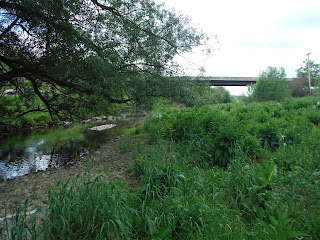Good to see quite a bit more water in the stream, than when I was there last time. Area that was completely exposed had better coverage.
You might not be able to see it here, but there are two lamprey nests immediately under the breaking water.
Another area that was completely exposed before that now was almost completely covered. The rocks had no algae growing on them so they could only have been covered by the water very recently.
Other species are extremely active at this time of year. Here is a small fish that was probably hatched last month. This is probably a black-nosed dace, but not promises, my larval fish id is not that good.
Here is a male damselfly (Calopteryx sp.). These are very attractive species because their bodies are usually metallic and shiny, and the wings are often dark or dusky. These come out early in the season and lay their eggs.
Here is one videos of the damselflies going about their business. The male is the prettier darker winged animal. He stands guard over plants that females will use to lay their eggs. He will chase off or attack other males, and females that have not bred with him. Males can be very aggressive they will actually grab and tear at the wings of the other individuals they don't want around.
The other video is too large for posting here so I have linked it from Youtube. Head over to here to watch it.
There you will watch the male guard over the female while she lays eggs. The eggs are laid by sawing into the plant and then depositing one egg at a time. The Oxygen the plant consumes will be stolen by the developing insect to help it grow. Once it is large enough it will hatch and head off into the world.
And what is this?! Could it be? A dead adult sea lamprey immediately next to where I sample. The spawning was complete and so any adults are either dead or dying. Now the adult bodies will drift downstream and contribute Phosphorus and Nitrogen as they decay.
Here is a close up of the lamprey, its journey is over. This animal was probably laid as an egg ~10 years, so let us say 2005. After its first year of life it weighed ~0.15g, and when it died it probably weighed close to 700g, and before it began its migration it easily could have weighed over 1000g.
I left the Delaware River and headed to the Hudson River again as planned. The weather was very warm (90F) and the sky was clear.
I worked under a bridge for the day, collecting, marking, and releasing ammocoetes.
Here is a picture of one of the sampling areas I work in.
Although eels should be common in the Delaware River I rarely see them. Here in the Hudson River they are more common. They look a lot like an ammocoete but notice the very clear eyes.
This is the same eel just with my hands for scale. I let him go shortly after this. I only collected him because he got shocked pretty good and wasn't able to move immediately so I picked him up to get him out of the current and make sure he could bury himself from predators.
This is looking upstream from where I worked. The site is in a small town park and you can see some of the playground on the right.
Almost all of this area is covered in leaves that have washed downstream, and that makes great habitat for ammocoetes. There are ammocoetes wall to wall here.
Although the water was not as high this time, it has been higher in the past. Just some of the wood that has been moved by the stream before.
That is all for now. Stay tuned for more updates.



























